The Critical Role of Fitness Shoes in Joint Health
For men dedicated to maintaining an active lifestyle, the importance of proper footwear extends far beyond comfort. Fitness shoes are engineered with specific technologies designed to cushion impact, provide stability, and support the biomechanics of the foot during various activities. Over time, the materials that provide these crucial functions degrade, leading to reduced support and an increased risk of joint stress and injury, particularly in the ankles, knees, and hips.
The cushioning in the midsole, often made of EVA foam or similar materials, compresses with each step, eventually losing its ability to rebound. The outsole’s tread wears down, reducing grip and stability. Neglecting to replace shoes at the appropriate time can turn a beneficial workout into a detrimental one for your joints.

Key Factors Influencing Shoe Lifespan
Several variables dictate how quickly a pair of fitness shoes will wear out. Understanding these factors can help men gauge their personal replacement schedule more accurately.
Activity Level and Intensity
The more frequently and intensely you train, the faster your shoes will deteriorate. A man who runs 30 miles a week will wear out his shoes significantly faster than one who walks 10 miles a week or visits the gym for light strength training a couple of times.
Type of Exercise
Different activities place different stresses on shoes. Running shoes are designed for linear motion and impact absorption, while cross-training shoes offer more lateral support for agility drills and weightlifting. Using a running shoe for aggressive court sports, for instance, will accelerate its breakdown.
Body Weight and Biomechanics
Heavier individuals or those with specific gait patterns (e.g., pronation or supination) tend to put more stress on their footwear, leading to quicker wear. Individual biomechanics can also cause certain areas of the shoe to break down faster.

Recognizing the Signs of Wear and Tear
While mileage and time are good guidelines, listening to your body and visually inspecting your shoes are crucial for knowing when it’s time for a replacement.
Visible Deterioration
- Outsole Wear: Look for bald spots or worn-down tread, especially on high-impact areas.
- Midsole Compression: Press your thumb into the midsole foam. If it feels hard and doesn’t spring back, the cushioning is gone.
- Upper Damage: Tears, holes, or stretched fabric can compromise the shoe’s support structure.
- Asymmetrical Wear: If one side of the sole is significantly more worn than the other, it indicates a loss of stability and potentially underlying biomechanical issues.
Loss of Cushioning and Responsiveness
Your shoes might look fine on the outside, but the internal cushioning can be completely dead. If your workouts feel harder, or you notice a lack of spring in your step, the shoes are likely past their prime.
New or Increased Joint Pain
This is often the most critical indicator. If you start experiencing unexplained aches or pains in your feet, ankles, knees, or hips after workouts, especially in joints that previously felt fine, your shoes are likely no longer providing adequate support.
![How To Tell If My Running Shoes Are Worn Out? [8 Key Signs]](/images/aHR0cHM6Ly90czMubW0uYmluZy5uZXQvdGg/aWQ9T0lQLmxLNkxTcFNBc29YR0x6OEg4Sm8zalFIYUVzJnBpZD0xNS4x.webp)
General Guidelines for Replacement Frequency
While individual factors vary, here are some widely accepted benchmarks:
- Running Shoes: Typically 300 to 500 miles, or every 4 to 6 months for regular runners.
- Cross-Training/Gym Shoes: Generally every 6 to 12 months, depending on usage intensity.
- Walking Shoes: Can last longer, often 500-800 miles or 9 to 12 months for frequent walkers.
For men who engage in varied activities, it’s wise to err on the side of caution. If you fall into the higher end of the usage spectrum or are a heavier individual, consider replacing your shoes closer to the lower mileage/time estimates.

Tips to Maximize Your Shoe’s Lifespan (and Your Joints)
- Rotate Shoes: Having two or more pairs of shoes and rotating them allows the cushioning to decompress and rebound fully between workouts, extending the life of each pair.
- Use Shoes for Intended Purpose: Don’t wear your running shoes for yard work or your cross-trainers as everyday casual shoes. This preserves their specific performance features for your workouts.
- Proper Storage: Store shoes in a cool, dry place. Avoid leaving them in a hot car, which can degrade materials.
- Clean Gently: Remove dirt with a soft brush and mild soap. Avoid machine washing or using harsh chemicals, which can damage adhesives and materials.

Conclusion
Replacing fitness shoes isn’t just about maintaining performance; it’s a critical investment in your long-term joint health and injury prevention. By paying attention to mileage, recognizing the signs of wear, and considering your activity levels, men can ensure their footwear continues to provide the essential support needed to pursue their fitness goals safely and effectively. Don’t wait until pain forces a replacement; be proactive in protecting your joints.




